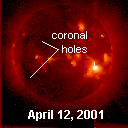|   SPACE WEATHER SPACE WEATHER
Current
Conditions
Solar Wind
velocity: 710.8 km/s
density:0.9 protons/cm3
explanation | more data
Updated: Today at 2247 UT
X-ray Solar Flares
6-hr max: B6 2020 UT Apr13
24-hr: B6 2020 UT Apr13
explanation | more data
Updated: Today at 2250 UT
Daily Sun: 13 Apr '01 
With its complex delta-class magnetic field, sunspot 9415 remains a threat for powerful flares. However, as the sunspot continues to rotate away from the Sun's central meridian additional explosions will be less squarely directed at our planet.
Sunspot Number: 159
More about sunspots
Updated: 12 Apr 2001
Radio Meteor Rate
24 hr max: 29 per hr
Listen to the Meteor Radar!
Updated: 13 Apr 2001 Interplanetary Mag. Field
Btotal: 6.6 nT
Bz: 2.0 nT north
explanation | more data
Updated: Today at 2247 UT Coronal Holes:

A pair of coronal holes appear to be developing in the Eastern half of the Sun's visible disk. Image credit: Yohkoh Soft X-ray Telescope.
More about coronal holes
 SPACE WEATHER SPACE WEATHER
NOAA
Forecasts
Solar Flares: Probabilities for a medium-sized (M-class) or a major (X-class) solar flare during the next 24/48 hours are tabulated below.
Updated at 2001 Apr 13 2200 UT
| FLARE | 24 hr | 48 hr | | CLASS M | 80 % | 70 % | | CLASS X | 25 % | 15 % |
Geomagnetic Storms: Probabilities for significant disturbances in Earth's magnetic field are given for three activity levels: active, minor storm, severe storm
Updated at 2001 Apr 13 2200 UT Mid-latitudes | 24 hr | 48 hr | | ACTIVE | 25 % | 35 % | | MINOR | 40 % | 15 % | | SEVERE | 30 % | 10 % |
High latitudes | 24 hr | 48 hr | | ACTIVE | 25 % | 35 % | | MINOR | 30 % | 25 % | | SEVERE | 40 % | 20 % |

Web server provided by
VPS Hosting
| What's Up in Space -- 13 Apr 2001
Subscribe to Space Weather News! AURORA ALERT: A coronal mass ejection (CME) hit Earth's magnetosphere between 0730 and 0800 UT (3:30 am and 4:00 am EDT) on Friday, April 13th. The impact sparked a strong geomagnetic storm, which is slowly subsiding.  If you're an aurora-enthusiast and you missed Friday morning's show, don't worry -- another CME is on the way. The expanding cloud, hurled into space by an X2-class solar flare on April 12th, could arrive late Friday or (more likely) Saturday and spark a new round of intense geomagnetic activity. Sky watchers located at geomagnetic latitudes higher than ~50 degrees should remain alert for Northern Lights.  AURORAS PAST: A pair of coronal mass ejections hit Earth's magnetosphere on April 11th, triggering a strong geomagnetic storm that lasted nearly 24 hours. At its peak the storm was a severe G4-category event. Sky watchers in northern Europe, where the auroras were remarkably vivid, described the light show as one of the best in years. See for yourself by visiting the AURORA GALLERY. AURORAS PAST: A pair of coronal mass ejections hit Earth's magnetosphere on April 11th, triggering a strong geomagnetic storm that lasted nearly 24 hours. At its peak the storm was a severe G4-category event. Sky watchers in northern Europe, where the auroras were remarkably vivid, described the light show as one of the best in years. See for yourself by visiting the AURORA GALLERY.
WEB LINKS: NOAA FORECAST | GLOSSARY | SPACE WEATHER TUTORIAL | LESSON PLANS | BECOME A SUBSCRIBER |  
Potentially Hazardous Asteroids (PHAs) are space rocks larger than approximately 100m that can come closer to Earth than 0.05 AU. None of the known PHAs are on a collision course with our planet, although astronomers are finding new ones all the time. [more]
On 13 Apr 2001 there were 299 known Potentially
Hazardous Asteroids ASTEROIDS GALORE: March was a good month for asteroid hunters. Between March 21st and 31st astronomers discovered seven Earth-approaching space rocks (click to view 3D orbits): 2001 FM129, 2001 FE90, 2001 FB90, 2001 FD58, 2001 FC58, 2001 FA58 and 2001 FO32. There is no danger of a collision with any of these asteroids. Earth-asteroid encounters (Mar 1 - Apr 30) 
- TOTAL LUNAR ECLIPSE: On Jan. 9, 2001, the full Moon glided through Earth's copper-colored shadow. [gallery]
- CHRISTMAS ECLIPSE: Sky watchers across North America enjoyed a partial solar eclipse on Christmas Day 2000 [gallery]
- LEONIDS 2000: Observers around the globe enjoyed three predicted episodes of shooting stars. [gallery]
 Feb. 21, 2001: Nature's Tiniest Space Junk -- Using an experimental radar at the Marshall Space Flight Center, scientists are monitoring tiny but hazardous meteoroids that swarm around our planet. Feb. 15, 2001: The Sun Does a Flip -- NASA scientists who monitor the Sun say our star's enormous magnetic field is reversing -- a sure sign that solar maximum is here. Jan. 25, 2001: Earth's Invisible Magnetic Tail -- NASA's IMAGE spacecraft, the first to enjoy a global view of the magnetosphere, spotted a curious plasma tail pointing from Earth toward the Sun. Jan. 4, 2001: Earth at Perihelion -- On January 4, 2001, our planet made its annual closest approach to the Sun. Dec. 29, 2000: Millennium Meteors -- North Americans will have a front-row seat for a brief but powerful meteor shower on January 3, 2001. Dec. 28, 2000: Galileo Looks for Auroras on Ganymede -- NASA's durable Galileo spacecraft flew above the solar system's largest moon this morning in search of extraterrestrial "Northern Lights" Dec. 22, 2000: Watching the Angry Sun -- Solar physicists are enjoying their best-ever look at a Solar Maximum thanks to NOAA and NASA satellites. MORE SPACE WEATHER HEADLINES |

